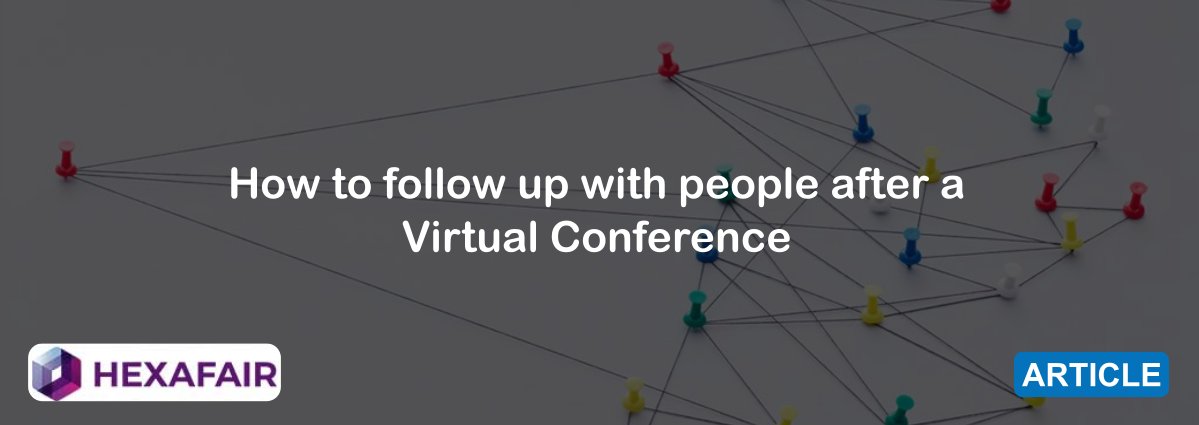Attending a virtual event is a whir of activities — engaging in several hours/days of continuous networking, gathering information from different exhibitors and at the end of the event, your inbox has spiralled out of control in your absence. Back at work, most of us immediately get into catch-up mode; the last thing on our minds is following up with the people we just met. That’s especially true if you’re an introvert and feel overtaxed by the whole process. Here’s a framework for structuring your virtual event follow up to maximize the chances that your new connections turn into meaningful professional relationships.
First, it’s important to set aside “processing time.” The 3D virtual event platform system allows you to export business cards scattered in your briefcase. The system doesn’t much matter; it’s personal preference whether you use a business card app or add them to a spreadsheet manually.
What matters is capturing the data (the people you met on the virtual event, business cards exchanged, documents viewed, exhibitor chats), and also making a list of people you spoke with whose cards you didn’t obtain. That may be a substantial number if the virtual event discourages card exchange (some conferences fear that people trading business cards will make the gathering appear too “sales”), or if your encounter has been brief, such as a chat. Probably, you hadn’t exchanged contact information with most of them, but they were still connections worth maintaining.
Second, for each person you’ve written down, take a moment to identify your goal for that relationship. You can’t invest in all connections equally, of course — so where should you prioritize your time? It’s not worth subjecting yourself to that in the future.
But most new relationships will fall into three categories. Specifically, those are “miscellaneous interesting people,” with whom there’s not an obvious point of connection; people with whom you have a specific reason to follow up; and people you’d like to build a deeper relationship with.
Table of Contents
Virtual Event Follow Up: Learn the Best Tips & Tricks
Miscellaneous interesting people:
On the 3D virtual event, for instance, you had a nice conversation with a woman who is an executive with the PLC. Your work doesn’t generally overlap with hers, but you’d be glad to keep in touch because it’s always nice to know a diverse set of people. For instance, in the future, you could imagine a hypothetical situation in which you were hired to speak to a shipping company. Having a contact knowledgeable about industry trends would be valuable as a way of understanding what was important to the client. Similarly, there may be unexpected ways you could assist her in the future.
For connections like that, you apply an “ambient awareness” strategy and send a friend request on LinkedIn, so that you can stay in touch through that channel and she may periodically be exposed to my posts in her news feed, and vice versa.
A specific reason to post-event follow up:
For other virtual event attendees, the mission is clearer: they mentioned specific business opportunities (an invitation to speak at a university, give a talk for a large company, etc.) you make a point of emailing them in a timely fashion — within a week is ideal — to remind them of their suggestion and request a post-event follow-up call.
How to Build Better Customer Relationships
Finally, at the 3D virtual event, you’ll meet some people with whom you’d like to build a long-term connection. Their work may be extremely salient to yours (they’re a VC and you’re an executive coach that works with start-ups), or you may just have great personal rapport. Either way, you want to develop a strategy to turn a one-time encounter into something more meaningful. If they live in your city, the options are more plentiful; you can invite them to join you at a future professional event, such as a Chamber of Commerce gathering, a tech meetup, etc., or to a hybrid business/social event (after meeting a theatre executive at a conference and hitting it off, he invited me to join him a couple of weeks later at a Broadway show for which he had an extra ticket).
If you live in different cities, you’ll need to develop a more deliberate post-event follow-up strategy. Perhaps future virtual events are coming up they might be likely to attend; you could get in touch to inquire if they’ll be there, and if so, plan to meet up in person during the event. If you’re a frequent business traveller, you can also put them on the list of people you ping when you’re in town for visits. Even if it’s unlikely you’ll meet in person again anytime soon, you can be on the lookout for interesting articles to send them, or look for ways to be helpful (for instance, if they mentioned they’re looking for new contributors for the magazine they edit, you could suggest talented colleagues).
Of course, it’s essential to make sure the help you offer is helpful; there’s a big difference between connecting an editor actively seeking contributors with great candidates, and connecting an overwhelmed editor with would-be columnists they don’t have the time to deal with. It’s essential to listen to their stated needs, not make assumptions about what might be useful and risk turning yourself into a burden in the process.
Almost every professional attends at least a few conferences per year. By following this virtual event follow up, you can make sure the time, effort, and money you spend on a 3D virtual event platform or a virtual event platform turn into true relationships, not just one-time conversations that are quickly forgotten.
For the latest virtual events updates, Talk to our experts today. For the latest releases on the 3D virtual event platform, stay tuned to our articles page.


